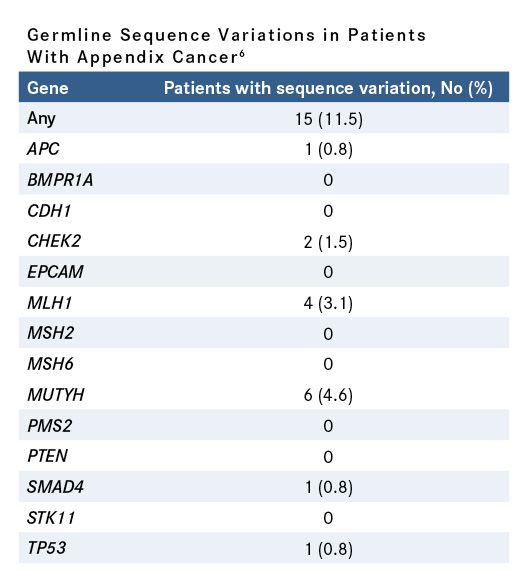Article
Investigators Struggle to Understand Causes Behind Growth of Appendix Cancer
Author(s):
Investigators are unclear about the factors driving the explosive growth in incidence of appendiceal cancer over the past 2 decades.
Andreana N. Holowatyj, PhD, MSCI

Investigators are unclear about the factors driving the explosive growth in incidence of appendiceal cancer over the past 2 decades. The disease remains extremely rare, but findings from a 2020 study showed that the overall incidence of malignant appendiceal tumors grew by 232% in the United States from 2000 to 2016.1
According to the National Cancer Institute, appendiceal cancer affects an estimated 1 or 2 people per 1 million population annually. Incidence increased across all age groups, sexes, and stages of disease, and investigators observed the highest rate of increase for appendiceal neuroendocrine malignant tumors diagnosed among the youngest age groups.
The rate of appendectomies remained stable during the 2020 study period, meaning that the rate of appendectomies per malignant appendiceal tumor diagnosis has declined. Most appendiceal tumors are diagnosed incidentally on a surgical specimen following appendectomy for acute appendicitis. Therefore, investigators concluded that the increased incidence is likely not due to increasing diagnosis of asymptomatic tumors during an appendectomy.
One of the challenges of diagnosing appendiceal cancer is that it often presents with nonspecific symptoms and is often mistaken for colon cancer. Many patients with early-stage disease complain of an acute pain similar to appendicitis, secondary to distention of the appendix by mucin. The patient may experience appendicitis or perforation of the appendix, especially if the tumor obstructs the appendiceal orifice.2
In the advanced stage, patients may have abdominal swelling due to the accumulation of mucinous ascites in the peritoneum. Patients may also present with chronic abdominal pain, weight loss, anemia, infertility, and new‐onset umbilical or inguinal hernias.
Historically, classification of these tumors has been complex. A literature review conducted by investigators with Belgium’s University Hospitals Gasthuisberg/Leuven and KULeuven and published in 2020 identified 4 subtypes: colonic-type adenocarcinoma, mucinous neoplasm, goblet cell carcinoma (GCC) and neuroendocrine neoplasm. The presence of signet ring cells is a histologic feature that can be present in colonic-type adenocarcinoma and mucinous neoplasms.3
Colonic-type adenocarcinoma is thought to make up 60% of tumors, making it the most common type of primary appendix cancer. That said, because of the overall rarity of appendiceal tumors, colonic-type adenocarcinoma comprises less than 0.5% of all gastrointestinal tract neoplasms. These tumors appear most often in patients with a mean age of 62 to 65 years.
Andreana N. Holowatyj, PhD, MSCI, an assistant professor of medicine and cancer biology at Vanderbilt University Medical Center and Vanderbilt-Ingram Cancer Center (VICC) studying gastrointestinal cancers, is at the forefront of appendiceal cancer research. She said in an interview with OncLive® that a surprising percentage of these cancers are appearing in younger patients.
“My team conducted a few studies, particularly one that wanted to look at the burden of appendix cancers in young adults,” she said. “And what we strikingly found there was that, in contrast to the fact that about 1 in every 5 colorectal cancer patients is diagnosed before the age of 50, we found that 1 in every 3 [30.8%] appendix cancer patients are diagnosed before age 50.4 Noting this really disproportionate burden in younger patients really spurred a lot of the subsequent work that my lab has done and continues to do.”
In patients with early-onset disease, the mean age at diagnosis was 37.5 years compared with 64.9 years for late-onset appendiceal cancer.
Patients with early-onset appendiceal cancer were also 2- to 3.5-fold more likely to be diagnosed with goblet cell carcinoid tumors (odds ratio [OR], 1.96; 95% CI, 1.59-2.41; P <.0001) or carcinoid tumors (OR, 3.52; 95% CI, 2.80-4.42; P < .0001) compared with patients with late-onset disease. Among patients with neuroendocrine tumors, younger patients were 45% less likely to present with grade 3 disease and 61% less likely to present with grade 4 tumors.
Furthermore, the burden of disease fell disproportionately on patients of color. Investigators identified 8851 patients aged 20 years or older diagnosed with appendiceal cancer from 2007 to 2016. They found that patients aged 50 years or younger were 82% more likely to be Hispanic (OR, 1.82; 95% CI, 1.48-2.25; P <.001) and 4-fold more likely to be American Indian or Alaska Native (OR, 4.02; 95% CI, 1.77-9.16; P = .0009) compared with late-onset cases.
Investigators assessed overall survival (OS) in 1652 patients younger than 50 years diagnosed with appendiceal cancer from 2000 to 2011. The 5-year OS rate was 75.5% among non-Hispanic White patients and 75.4% for Hispanic patients, but only 63.0% for non-Hispanic Black patients. The 5-year cancer specific survival rates were 77.0%, 79.2%, and 64.5%, respectively.5
The distinct clinicopathologic/demographic features of early-onset appendiceal cancer remain unknown but historically, investigators have not believed the disease is hereditary. Holowatyj is leading the National Cancer Institute Appendiceal Cancer Consortium (APPECC) study exploring why incidence of appendiceal cancer is growing so rapidly and elucidating risk factors for the disease.
“Appendix cancer, much like many other cancers, has a lot of different characteristics on a cellular level, or what the cells look like under the microscope,” she said. “So, there’s a lot of pathological differences that lead to different histologies. Again, with the rarity of this malignancy, it's really hard to study. Specifically, what is the genetic predisposition in this one group of patients with, let's say, appendiceal adenocarcinoma versus goblet cell carcinoma? That's the trajectory we're hoping to move forward in with our clinical study that's now open at Vanderbilt and across the country, for patients with appendix cancer, but it’s too soon to say.”
Holowatyj and her colleagues published data assessing the prevalence and spectrum of inherited cancer susceptibility gene sequence variations in patients with appendiceal cancer and the utility of germline genetic testing for this population. They conducted germline testing on 131 patients with appendiceal cancer and found that approximately 1 in 10 patients carried an inherited gene sequence variation associated with cancer susceptibility.6
Investigators identified 16 deleterious sequence variations in 15 patients (11.5%; see Table). When they limited testing to the 74 patients with AC as the first and only primary tumor, 8 patients (10.8%) had at least 1 deleterious sequence variation in a cancer susceptibility gene.
Germline Sequence Variations in Patients With Appendix Cancer6

“That study really is the tip of an iceberg, and potentially quite a big iceberg, in that it’s spurred us opening a clinical study both at Vanderbilt and nationwide called the Genetics of Appendix Cancer study or GAP [NCT05734430], where any individual diagnosed with appendix cancer in the United States is eligible to participate and will help us learn more about this genetic predisposition and these genetic factors overall,” Holowatyj said.
References
- Singh H, Koomson AS, Decker KM, Park J, Demers AA. Continued increasing incidence of malignant appendiceal tumors in Canada and the United States: a population-based study. Cancer. 2020;126(10):2206-2216. doi:10.1002/cncr.32793
- Shaib WL, Assi R, Shamseddine A, et al. Appendiceal mucinous neoplasms: diagnosis and management. Oncologist. 2017;22(9):1107-1116. doi:10.1634/theoncologist.2017-0081
- Van de Moortele M, De Hertogh G, Sagaert X, Van Cutsem E. Appendiceal cancer : a review of the literature. Acta Gastroenterol Belg. 2020;83(3):441-448.
- Gibbs T, Washington MK, Eng C, Idrees K, Davis J, Holowatyj AN. Histologic and racial/ethnic patterns of appendiceal cancer among young patients. Cancer Epidemiol Biomarkers Prev. 2021;30(6):1149-1155. doi:10.1158/1055-9965.EPI-20-1505
- Holowatyj AN, Washington KM, Salaria SN, Lieu CH, Idrees K, Eng C. Early-onset appendiceal cancer survival by race or ethnicity in the United States. Gastroenterology. 2020;159(4):1605-1608. doi:10.1053/j.gastro.2020.06.011
- Holowatyj AN, Washington MK, Tavtigian SV, Eng C, Horton C. Inherited cancer susceptibility gene sequence variations among patients with appendix cancer. JAMA Oncol. 2022;9(1):95–101. doi: 10.1001/jamaoncol.2022.5425









